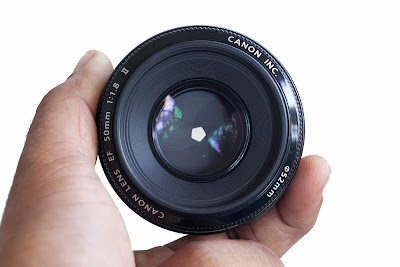 |
| macro photography reverse lens technique |
Most modern DSLR lenses do not have an aperture ring with which you could set the aperture; instead the opening and closing of aperture is controlled by the camera body. This is all fine when you use the lens normally (as intended); but when you reverse mount a lens, it loses all electrical contact with the camera and this causes different lenses to behave differently.
Lenses with Manual Aperture Control
 |
| lens with manual aperture control |
Lenses with manual aperture control is pretty straight forward you set the lens wide open, focus, set the required aperture and take the picture. Only thing to pay attention is to keep the camera steady so that the focus does not shift with camera movement when you try to stop down your lens.
Canon Lenses - Locking the aperture of EF and EF-S lenses
Canon EF and EF-S lenses default to its maximum aperture (wide open / lowest f number) when dismounted from the camera. This is how a canon 50mm f/1.8 looks when it’s taken off the camera.
 |
| Reverse lens macro photography - how to lock aperture |
If you use this lens reversed then you will find you will be working with very very shallow depth of field, which will work for some subjects but will not be sufficient in most cases. The trick to use narrow apertures to get increased depth of field is simple.
1. Mount the lens normally on a camera
2. Turn on the camera
3. Set the camera to Manual (M) mode
4. Set the aperture desired
 |
| how to lock a lens at a certain aperture |
5. Dismount the lens while holding down the Depth of Field Preview button and Lens Release button.
 |
| lens reverse macro tutorial |
6. Remember the camera should be on while the lens is being removed.
Pressing the depth of field preview button causes the lens to stop down to the set aperture and when you dismount the lens while keeping the depth of field preview button pressed you are effectively locking the lens aperture at that setting. The lens iris will remain at the set aperture and will only go back to normal when you remount the lens the right way round on your camera.
 |
| how to lock aperture of a lens at a certain setting |
One disadvantage of this technique is that the camera is on when you remove the lens and electrical charges on the sensor can attract dust.
Nikon G Series and Other Lenses
Nikon lenses behave differently than canon lenses, for example aperture on Nikon G Lenses are spring loaded so it makes the aperture blades to close down to its minimum aperture the moment you take it off the camera.
So the problem with Nikon lenses is that its very hard (almost impossible) to see through the viewfinder when it is reverse mounted and using the lens fully stopped down will also reduce image quality due to diffraction. That is why you need to find a way to lock aperture somewhere in the middle, not fully open and not fully closed.
Nikon G lenses physically needs the aperture feeler to be holing it in place to stay open. Look for a tab sticking out at the rear of your lens; it should be in a slot and it slides about inch or so. Locate it and move it with your finger check to see if it controls the aperture blades, if so you could lock the aperture at any setting by inserting a small slim made of folded paper or a piece of business card or anything similar that will snugly fit in. Remember it should not be loose so that it slides off and not too tight so that it damages the lens.
One alternative approach which might take a little practice to master is to hold open the tab with your finger, and release it when shooting.
Here are a few shots taken with reverse lens technique for inspiration.
 |
| canon reverse lens |
 |
| how to reverse a lens for macro photography |
 |
| locking aperture for reverse lens macro photography |
 |
| locking aperture for reverse lens macro photography |
 |
| reverse lens macro digital photography |
 |
| reverse macro lens adapter |
By: Jishnu Satheesh Babu do check out some of his amazing revere lens shots on Facebook, Flickr and 500px.